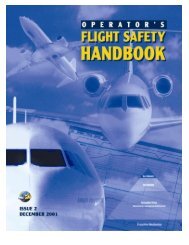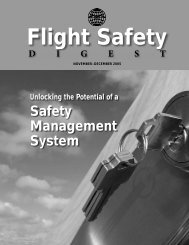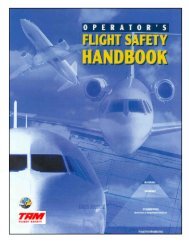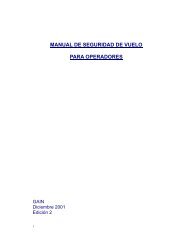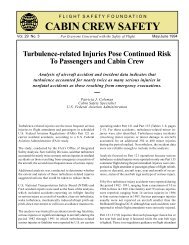Download PDF [10.9 MB] - Flight Safety Foundation
Download PDF [10.9 MB] - Flight Safety Foundation
Download PDF [10.9 MB] - Flight Safety Foundation
Create successful ePaper yourself
Turn your PDF publications into a flip-book with our unique Google optimized e-Paper software.
measured and estimated runway friction<br />
and aircraft braking coefficients can lead<br />
to landing distances or maximum landing<br />
weights that also are uncertain or inaccurate.<br />
“This has contributed to accidents and incidents<br />
where aircraft departed runways because<br />
the surface was more slippery than expected,”<br />
according to the executive summary of a study<br />
released in 2011 by the Accident Investigation<br />
Board Norway (AIBN). 1<br />
In 30 investigated occurrences, the AIBN<br />
found that “aircraft braking coefficient (ABC)<br />
was not in accordance with the measured/<br />
estimated runway friction coefficients (FC).”<br />
In its study, the AIBN identified a number<br />
of common factors that have reduced safety<br />
margins, and factors that explain the differences<br />
between ABC and FC. “These factors are<br />
related to meteorological conditions and friction<br />
measurement uncertainty, runway treatment,<br />
operational aspects and regulatory conditions,”<br />
the AIBN study said.<br />
Among the factors is the wetness of snow, or<br />
the volume percentage of liquid water in frozen<br />
runway contamination. The author carried out<br />
a study of wetness in frozen contamination at<br />
Svalbard Airport, Spitsbergen, Norway, from<br />
2009 through 2012 under the auspices of AIBN in<br />
order to better understand aircraft winter operations<br />
following the board’s comprehensive report.<br />
Results of the author’s study show that wetness<br />
in falling snow, or recently fallen snow, decreases<br />
with surface air temperature, except for<br />
specific cases related to temperature inversions.<br />
Recently fallen snow that is not exposed to further<br />
precipitation or thawing partially dries up<br />
in the course of hours, thus improving braking<br />
conditions. In such situations, estimated aircraft<br />
braking performance based on the ABC value<br />
closely correlates with contemporary observed<br />
wetness in samples of frozen contamination.<br />
Essential Indicators<br />
As shown by the 2011 AIBN study, measurements<br />
of braking action by conventional devices<br />
are difficult to rely on, particularly in the critical<br />
© Jorgen Syversen/AirTeamImages Lingering uncertainty associated with<br />
FLIGHTSAFETY.ORG | AEROSAFETYWORLD | MAY 2013<br />
AIRPORTOPS<br />
temperature range near freezing or when there is<br />
wet, compacted frozen contamination. The present<br />
study draws attention to wetness in frozen<br />
contamination. Though interrelated, wetness and<br />
surface temperature, together with the three-kelvin-spread-rule<br />
(which indicates that a difference<br />
between dew point and METAR, the current<br />
aviation meteorological report, air temperature [2<br />
m or 6.6 ft above the runway surface] of 3 three<br />
kelvins or less indicates that the humidity is 80<br />
percent or more; a kelvin [K] is 3 degrees C or 5.4<br />
degrees F), might prove to be essential indicators<br />
for braking action to be expected. 1,2<br />
Recent snow may contain a large proportion<br />
of liquid water. When such snow is compacted,<br />
its surface becomes coated with a film<br />
of liquid water, hence the ability to transfer<br />
shear force (that is, braking) at the microscopic<br />
level between tire and runway surface materials<br />
is reduced. Similar conditions happen when<br />
compacted snow or ice is thawing at its upper<br />
surface. Compressed snow transformed to ice<br />
disintegrates gradually when the melting point<br />
temperature is approached as the surfaces of<br />
frozen particles are enveloped by liquid water.<br />
The static stability of the ice decreases and reinforces<br />
the lubricating effect of free liquid water<br />
in contact with a decelerating tire.<br />
Additional liquid water is generated in the<br />
footprint of tires due to the flash melting of ice<br />
caused by tire dynamics. Experience shows that<br />
the total outcome of braking as described by the<br />
ABC is partially related to the portion of liquid<br />
water in the frozen contamination. That portion<br />
might be relevant for runway management.<br />
Moisture Measurement Challenges<br />
To determine wetness in snow or ice, the difference<br />
in permittivity (the dielectric constant3 )<br />
of frozen versus liquid water often is used by<br />
micrometeorologists in this area and has turned<br />
out to be useful in snow and ice research. The<br />
Denoth Dielectric Moisture Meter4 is based on<br />
that difference and allows the proportion of<br />
liquid water to be determined when the density<br />
of the snow is known. A flat capacitive sensor<br />
was used in the author’s research, with one side<br />
| 19


![Download PDF [10.9 MB] - Flight Safety Foundation](https://img.yumpu.com/18550968/21/500x640/download-pdf-109-mb-flight-safety-foundation.jpg)

![Download this Issue [PDF 7 MB] - Flight Safety Foundation](https://img.yumpu.com/18859635/1/190x245/download-this-issue-pdf-7-mb-flight-safety-foundation.jpg?quality=85)
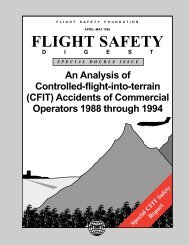
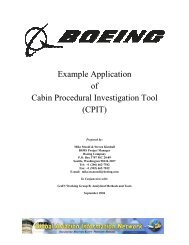
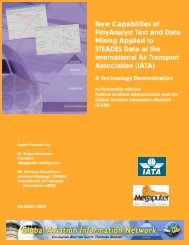
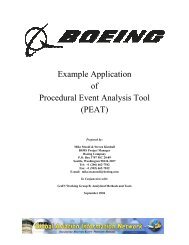
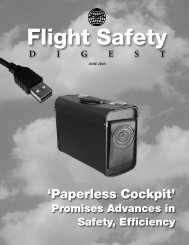
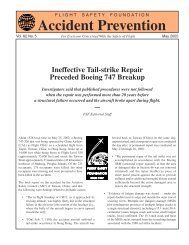
![Download [PDF 8 MB] - Flight Safety Foundation](https://img.yumpu.com/18859366/1/190x245/download-pdf-8-mb-flight-safety-foundation.jpg?quality=85)
